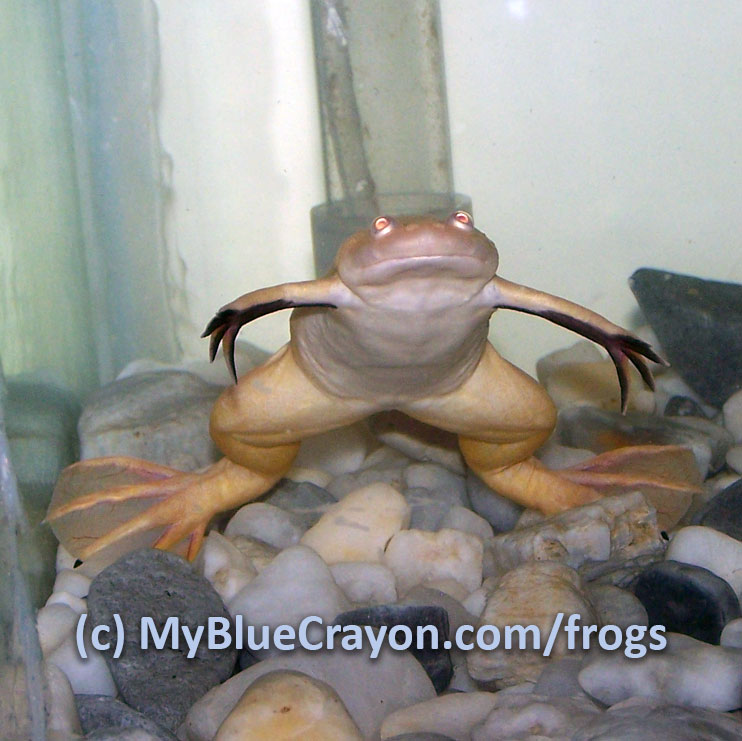African Clawed Frog FAQ
Help! My frog is shedding!
It is normal for African Clawed Frogs to shed their skin from time to time. Many of them eat it. – As long as your frog doesn’t seem extra sluggish and doesn’t have red spots that appear to be irritated, it should be fine.
If your frog’s skin appears to be irritated along with the shedding, check the condition of the water. (Testing strips can be purchased from the fish section of many department stores such as walmart.) Also, think back to if the tank has gotten too hot (over 80 degrees) lately. Search online for further information or advice.
Is my African Clawed Frog a boy or a girl?
It is impossible to tell the difference between a male African Clawed Frog and a female African Clawed Frog while they are young. But somewhere in the 18 months – 2 years mark, it becomes very obvious.

Froggy Arms
As they reach maturity, male African Clawed frogs will turn dark red or black (usually more black) on the undersides of their arms / front legs. The dark color may fade or shed off and come back often. Don’t worry – this is normal.
Girls are bigger than boys.
Girl frogs can grow significantly bigger than boys. But as I have learned from raising my own frogs, they don’t always. (My female is noticeably bigger than my males, but they are close enough in size that you can only tell when they are close to each other.)
How do I breed my African Clawed Frogs?
If you want to breed your African Clawed frogs, make sure you have a plan of action that includes where you will keep the babies, what you will do with them when they are grown, and how many you can actually handle.
Please do not breed frogs that are related to each other. From what I have heard and even experienced in my own fish tank – the defect rate is rather high with inbred frogs. (Out of the 15 eggs we decided to raise, 13 turned into tadpoles. As the tadpoles became frogs – we realized that about half had messed up legs and one had an enlarged heart.)
I have heard that it can be hard to breed African Clawed frogs. Especially if you have a small or over-crowded tank. I have 1 female and 2 males in 50 gallons of water and can’t get them to stop! They are most active after a water change.
My African Clawed frog laid eggs! What now?
If you are not ready to take on the responsibility or raising the tadpoles, either clean the eggs out, stick them in paper towel, and throw them away, or leave them in the tank and your frogs will eat them. If the frogs miss a few eggs durring their feast – you will see tadpoles swimming around in a week or two. They will be eaten too as soon as the frogs get hold of them.
If you do want to raise some tadpoles, get a clean container to put them in. Fill it with water from the tank and gently collect eggs. The easiest way I have found to collect eggs is to just pick up an artificial plant or rock from the aquarium and put it in the water.
Get a bubblestone to keep the water aerated. If it isn’t already, slowly get the water temperature around 75 degrees and keep it there. Have a filter or a turkey baster ready to clean up after them.
2 days – 1 week later, you will see that the round little eggs have turned into more of a c-shape. This is not a shell left behind after hatching – it is the actual tadpole starting to take shape! From this point there will be a noticeable difference in the tadpoles almost every day until they become frogs. Sometimes the difference will be small. Sometimes you will be amazed!
What do I feed my tadpoles?
You can buy special tadpole food from xenopus.com or go to your local petstore and look for HBH tadpole bites. (The tadpole bites are much cheaper if you are just raising a few.) If there is not a pet store with tadpole bites near by, Amazon has some good reviews for Zoo Med Aquatic Frog & Tadpoe Food. But these reviews also say that it dissolves. I would suggest looking into pellets once your frogs grow.